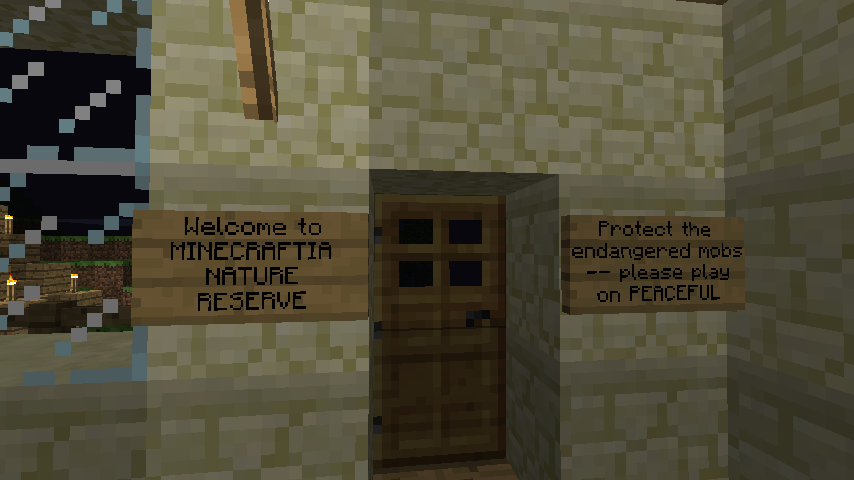Minecraft is an endlessly entertaining game because it doesn’t have a plot, an end boss, a time limit, any rules, or any objective at all. This open-endedness forces you to invent your own goals, and it makes for many different modes of gameplay. However, the most common way to play (aside, maybe, from pixel art) goes like this: Wake up on island. Punch trees. Hide from monsters. Make weapons. Fight monsters. Start a strip mine or a quarry. Build a monster-proof base with a tree farm and a mob grinder. Move on to redstone-wired minecart railways. Etc.
I think this gameplay exemplifies a culturally ingrained way of thinking about colonization, nature, and the concepts of wilderness/frontier and exploration. You’re the only human; the land is uninhabited (because neither animals nor monsters count as persons), and you have a perfect right to extract natural resources and kill (naturally) hostile monsters as you see fit. Your goal is to establish control over nature, and by introducing civilization in the form of fortresses and farms, you are imposing order onto chaos. The unfortunate historical associations should be obvious…
Now, you could argue that aspects of this narrative are built into the game, which, after all, was not created in a cultural vacuum. You can turn monsters off, but there’s no way to make them friendly. The tools you can craft include pickaxes, swords, and bows. Et cetera. But much of the fun of Minecraft comes from players exploiting glitches or finding alternate uses for features in order to play the game in new, unintended, and certainly unexpected ways. It is possible to deliberately flip the script, and players are doing it all the time.
One of the first examples I happened to come across was the clan called Anarcho-Communists of Minecraftia (original forum thread). On multiplayer servers, economies often emerge, formally or informally–there are even mods like iConomy that allow admins to regulate currency and shops. The ACoM anticipated this and formed a group of strictly anti-capitalist players.
As for singleplayer, here are some threads from /r/minecraft where people share their own gameplay styles. There’s nomad mode:
I spend most of my time exploring and gathering the few resources I need to keep going. In the afternoon I start looking for a place to set up for the night. These are often in the side of a hill, in natural caves that I make minimal patches to for safety, or even just a simple dirt house near the water. The goal is simple: affect the landscape as little as possible. Reuse and maximize use of supplies. Never stay in one area longer than necessary, or if you do make it a temporary home, keep it as simple as possible. No big structures, no wasted resources. No hoarding of supplies or resources. Take only what is needed.
Then there’s Falloutcraft (a. k. a. Morlock or Moleman), where you spend the entire game underground; or Windwaker (island-hopping)–I imagine this would work well by using Biome Terrain Mod to create an archipelago-type map.
My favourite so far, though, is “caretaker forest elf” and (from comments) similar styles like “caretaker dwarf” and “hollower”:
The caretaker elf doesen’t extract dirt or stone, but she might want to bait creepers to blow on materials she might want to gather. She has no qualms about this since creepers want to blow up anyway. The World was birthed by a giant creeper, after all.
The caretaker exploits natural formations while making structures – building with them, not demolishing them. She also replants trees after killing them, preferably more trees than before, so that she enriches the world.[…] Interesting problem: does this giant grass plain really want me to plant trees everywhere? should i go somewhere else to do that if the plains want to be endless and grassy? you may not care about this, but the caretaker elf does!
Another commenter describes their style as Lonely Vault-Builder:
I build a little home just under the surface, leaving the environment around me as untouched as possible. I build underground gardens to supply me with easy renewable resources, hidden arbors going down to bedrock (with light shafts and careful bracing). I leave only to collect sand from empty isles or wool from roaming sheep. Once I have a safe, sustainable home (with just a touch of glass, light and pleasing architecture) I wander around for a while, at a loss for what to do.
[…] edited to add: Unrelated to the above, I’ve also started embracing a relatively ‘cruelty-free’ playstyle. I don’t kill pigs or cows, and I only punch sheep enough to shear them. (I once accidentally punched a sheep into lava. It was quite sad D:) I only attack monsters that are coming after me, though I’ve no qualms about picking up bones and feathers after dawn […]
All this has got me thinking about how I could change up my more-or-less conventional gameplay. I recently downloaded a map with lots of little islands and open sea. Now, I could establish a base on one of the larger islands, with a mine and a nice house, and light up and mob-proof the islands one by one…but I think I’ll try something different. I’ll build treehouses or camp out in caves, mine only ores that are already exposed (which means just coal and possibly iron), and replant a tree for every one I chop down. I’ll do my best to build good shelters, but I don’t plan on making weapons, so if a spider or creeper gets me–well, if I die, I die! (No big deal, as I don’t plan on accumulating much stuff anyway.) I’ll make a little boat and journey from island to island. It’ll be an adventure!
